Erie Railroad history starts, surprisingly, with a canal.
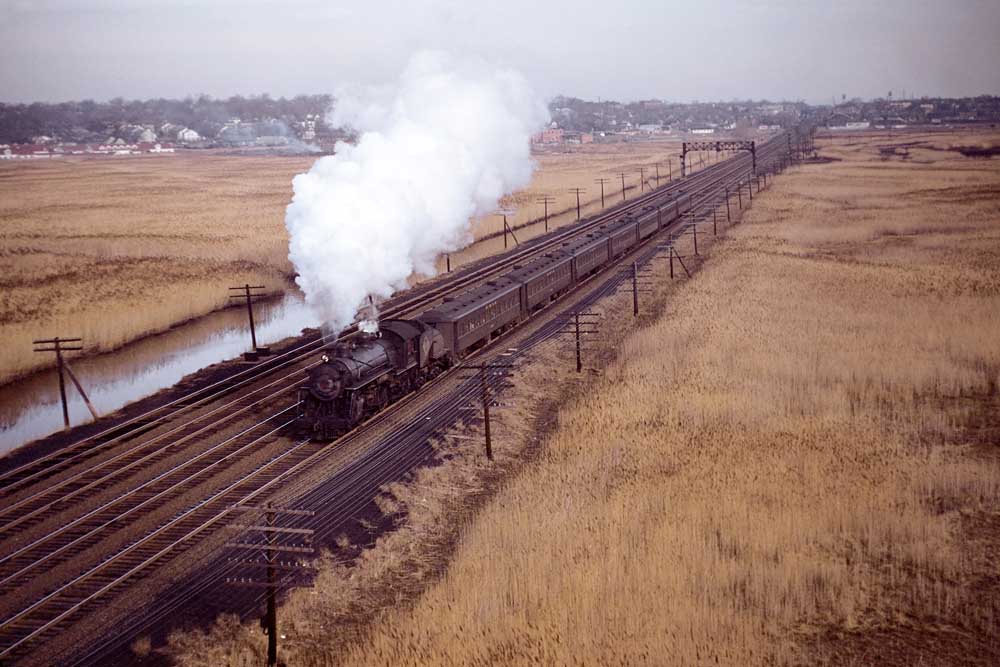
“The Work of the Age” was a proclamation by New York City’s Common Council upon the opening of the 300-mile New York & Erie Railway in 1851, “Erie” referring to one of the Great Lakes. New York City had become the natural gateway to the west decades earlier. The city’s excellent harbor, the Hudson River, and the Mohawk Valley provided a premier access route to the Great Lakes. Thus was the Erie Canal, completed in 1825, the first thoroughfare for the westward-seeking “Course of Empire” energy of the young United States. The canal’s success reinforced, if not initiated, New York’s proprietary adoption of the “Empire State” slogan.
To gain support for his “ditch,” New York Gov. DeWitt Clinton had promised the downstate counties their own transportation corridor, and in 1829 visionary promoter William C. Redfield explored what became the route of the New York & Erie. He issued a pamphlet proposing this “Great Railway” between the Hudson and Mississippi rivers. This was also the year of the Stourbridge Lion’s mechanical success at Honesdale, Pa., thus lending credibility to Redfield’s project. Sharing his vision, and co-incorporator of the NY&E in 1832, was Eleazar Lord, of Piermont, N.Y., a promoter, landowner, business leader, and eventual three-time president of the railway.
Despite the canal lobby’s efforts to stall the nascent railway, celebrated engineer Benjamin Wright was employed to find a route from Piermont, 24 miles north of New York City, to Port Jervis, and then up the Delaware River and over mountains, through the state’s Southern Tier and on to Lake Erie and the national interior. In an age when sections and states jealously protected their commercial and transportation interests, New York initially confined the route within its borders with a 6-foot gauge to prevent diversion of traffic and profits among neighbors (broad-gauge remnants would exist into the 1880s). Eventually it would establish better terminals than Piermont (on the Hudson) and Dunkirk (on Lake Erie), and seeing the logic of interchange, convert to standard gauge. Wright said $4,726,260 would build the route, but almost six times that would be required. Ground was broken Dec. 7, 1835, by James Gore King, NY&E’s second president, at Deposit, N.Y.
Moody’s 1949 Investor’s Manual reported early Erie Railroad history as being “… characterized by a succession of scandals, frauds, and mismanagements, in the face of which it maintained a surprising stability …” and further, “… it was not able to completely recover from the heavy financial burdens incurred earlier.”
Such was the character of Erie through the 19th century. Construction would be sporadic for years as funding was tough to acquire because of sectionalism, political roadblocks, internecine conflicts, and business depressions, but Lord was able to get state legislative aid as the advantages of the route were increasingly recognized. His plan of state grants to match public subscription solved one financial crisis.
Early railroading was rife with trial-and-error in funding as well as construction technology. Lord’s curious idea of putting the roadbed up on piles to meet topographical irregularities, wetlands, and winter snows was a prime example. Before this was deemed impractical, some 100 miles were up, and much money had been spent. Stationary engines were considered to pull trains up steep grades.
The first train ran in June 1841 over the 18 miles between Piermont and Ramapo (present-day Suffern). That fall, service opened to Goshen, 28 miles farther west. However, the company was broke again, and for the third time Lord assumed the presidency. He pressed for legislation to complete the route.
The NY&E reached Port Jervis at the end of 1847 and Binghamton in ’48, the latter segment including the magnificent Starrucca Viaduct. Dunkirk was now but 250 miles away. With the completion of each mile, the builders were expanding the technologies: the limits imposed by grades, a need for strong yet flexible roadbed for ever-heavier locomotives, construction methodology and machinery, surveying skills, bridge- and viaduct-building, and iron-working.
All were met with increasing knowhow and confidence. In fact, the first iron rails manufactured in America were used on the NY&E. The line reached Dunkirk in 1851, and for a time the NY&E was the longest railroad in the nation. On board the first through train were U.S. President Millard Fillmore and Secretary of State Daniel Webster, who, for a better view, rode in a rocking chair on a flatcar.
The 1850s and ‘60s saw additions and line improvements, if not financial success. Leasing of the Paterson & Hudson River and the Paterson & Ramapo made for a more direct route from Ramapo to the Hudson River. Work began on a tunnel under Bergen Hill for even better access at Jersey City, where subsidiary Long Dock Co. built NY&E’s own waterside facilities: Pavonia Avenue Terminal. Eventually yards would extend north into Weehawken and be served by one of the harbor’s largest rail marine fleets. Ferry routes to lower Manhattan were added, and a network of branches began reaching into northern New Jersey and southeastern New York.
To the west, new lines reached north to Buffalo and Rochester. Through service to Chicago was established via western connections, and Superintendent Charles Minot added to Erie’s impressive “list of firsts” with the creation of train-order operation, which became an industry standard. Raising capital, though, still was seldom easy, and in the 1850s, Daniel Drew, Jay Gould, Jim Fisk, and Cornelius Vanderbilt offered aid. This led, however, to their manipulation of Erie stock and the line’s reputation as the “Scarlet Woman of Wall Street.” In 1859 came receivership (the first of four) and reorganization as Erie Railway in 1861.
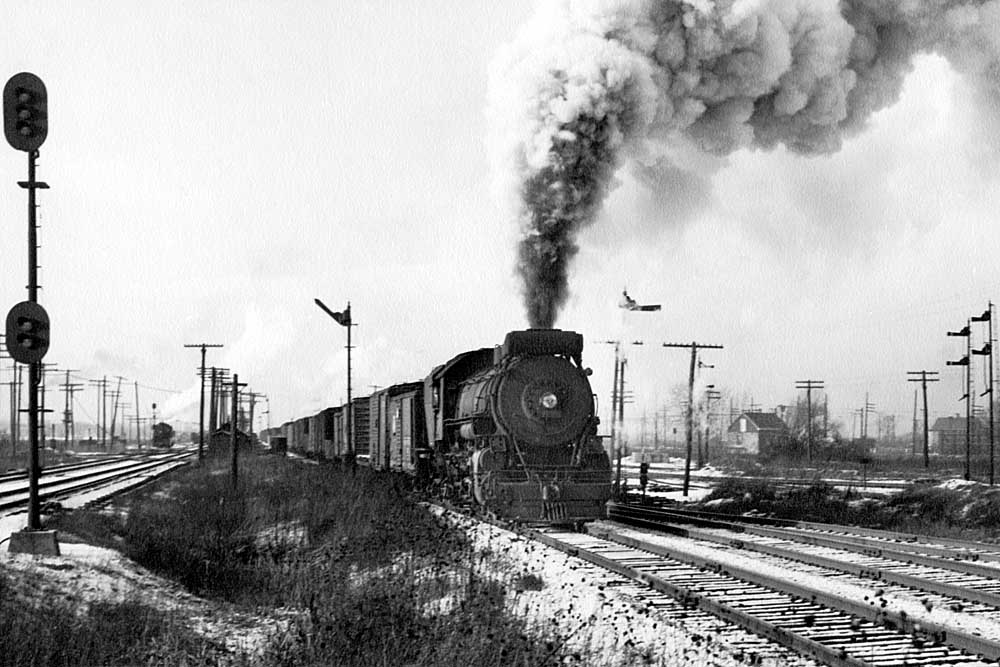
Beyond the Empire State
The developing Pennsylvania anthracite region offered large volumes of traffic in response to the Civil War’s industrial and military requirements, and the Erie reached south into the Lackawanna Valley with two routes that became the Jefferson and Wyoming divisions. These lines eventually connected with other roads for general freight interchange as well as coal. Farther west, the Tioga and Bradford divisions tapped bituminous coal beds. As locomotive fuel changed from wood to coal, Erie’s coal-mining subsidiaries moved their product for all customers on home rails. By 1860, Buffalo was surpassing Dunkirk as a lake port and rail hub, and the Erie enjoyed a good Buffalo passenger business.
Jay Gould, as an Erie board member and president during 1867-1872, left a mixed legacy. Having transcontinental ambitions, he rebuilt the Erie after the Civil War and pushed it toward Chicago. The Atlantic & Great Western, organized by Ohio interests, was largely funded by British capital and after its reorganization as the New York, Pennsylvania & Ohio, was leased to the Erie in 1883. Its earlier acrimonious relationship with the Erie included a battle to remove Jay Gould from the presidency. The A&GW served highly valuable coal and oil fields and extended the Erie main line west from Salamanca, N.Y., 300 miles to Marion, Ohio, with branches to the important cities of Cleveland and Dayton. Marion, on the main line, would become Erie’s western hub. Acquiring A&GW brought a host of challenges to the Erie, partially contributing to its second bankruptcy, from which it emerged in 1878 as the New York, Lake Erie & Western. A key achievement was finishing the conversion of main lines to standard gauge in 1880, but it would be five more years before branches and yards were changed.
Equally important was reaching Chicago if the line was to compete effectively with the Baltimore & Ohio, Pennsylvania, and New York Central. This was accomplished in 1883 under President Hugh J. Jewett. In 1873, the Chicago & Atlantic Extension Railway was formed by the Erie, the old A&GW, and other interests. By completion in 1880 it had become the 270-mile Chicago & Erie, from Marion to Hammond, Ind. From there, the Chicago & Western Indiana, owned by several roads including the Erie, gave access to the new Dearborn Station and western freight connections. At 1,000 miles, NYLE&W was not the shortest route between New York and Chicago, but it had a relatively low-grade profile compared with its competitors and would establish a good reputation for moving time-sensitive freight as well as, owing to its broad-gauge beginnings, oversize loads. It also boasted a fine saltwater terminal. Erie’s passenger services offered quality if not the most modern accommodations to a loyal following, and the route’s scenery was among the best in the East.
Crisis again loomed, however, with the 1893 financial panic. NYLE&W fell, as did many other roads. There was still the crushing burden of debt from the Drew and Fisk era, plus recent labor strikes, low freight rates, and ruinous competition. In 1895 the company was reorganized for the third time, now as Erie Railroad. It soon came under J. P. Morgan’s anthracite roads “community of interest,” and with the new century came an improved national economy. Erie’s tonnage soared, and income followed. The capable Frederick D. Underwood arrived in 1901, at Morgan’s request, to lead the Erie into an era of reconstruction and improvements. He also had the friendship and financial support of E. H. Harriman.
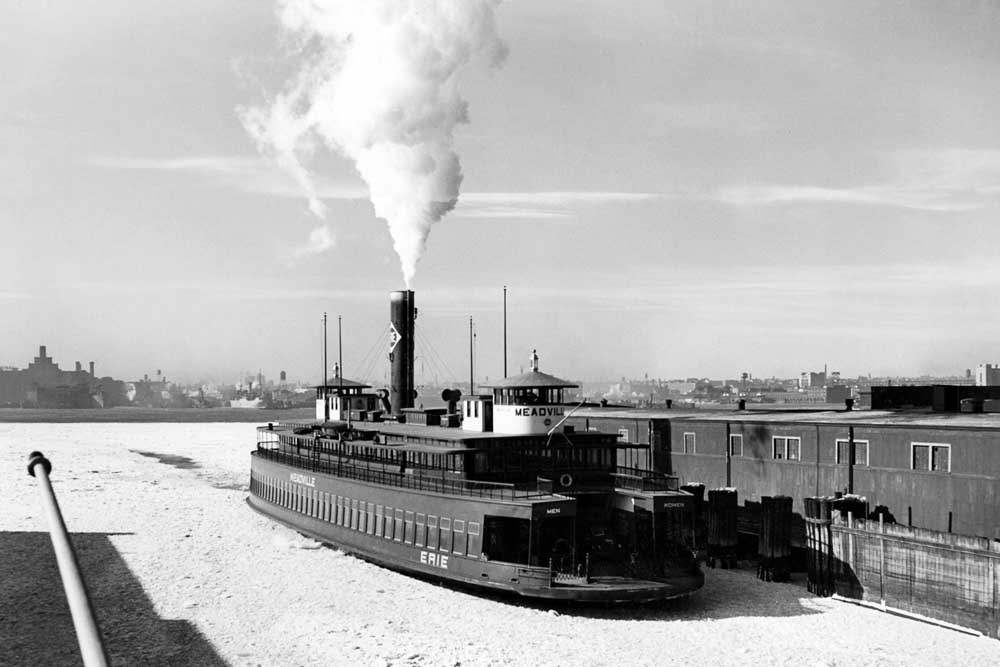
20th century improvements
Under J. M. Graham, engineering V.P., three major route improvements reduced grades and made for more competitive transit times. The Bergen Archways project, just west of the Jersey City terminal, put four tracks through the Palisade Ridge, reducing a bottleneck; the original double-track tunnel became freight-only. Underwood bought some of the largest steam locomotives of the era, including three 2-8-8-8-2 triplexes, naming some for notable engineers. Recognizing the loyalty and reliability of others, he created the “Order of the Red Spot.” Upon his idea, the first railroad employees’ magazine appeared in 1905.
One of the 1920s consolidation efforts to come out of the post-U.S. Railroad Administration period was that of the Van Sweringen brothers, who began buying into the Erie in 1922 as they wished to add a direct line to New York to their Nickel Plate Road, Chesapeake & Ohio, and Pere Marquette. In 1927 they charged John J. Bernet, a proficient railroader, to administer the Erie, and he continued the program of betterments begun by Underwood. The road became more efficient by scrapping hundreds of worn freight cars and more than 400 old locomotives, and by the addition of modern devices to cut fuel consumption by half.
Bernet brought in 2-8-4s (Erie eventually had 105), which assured a continued share of fast freight business. His 2 ½-year tenure, while certainly improving the Erie (it also paid the first preferred stock dividend since 1907), would not insulate it, however, from the economic storm of the 1930s. The Van Sweringens’ parent holding company went bankrupt with the stock market crash, the component roads were sold, and the two brothers died in the mid-1930s. Charles E. Denney, a Bernet protege from the Nickel Plate and highly respected in his own right, led Erie through the Depression.
Gross revenue dropped from $129.2 million in 1929 to $72 million in 1936. C&O refused to guarantee a $6 million government loan to pay taxes, vouchers, and bond interest. Denny and Cleveland lawyer John A. Hadden were appointed trustees overseeing a comparatively smooth fourth reorganization, completed in 1941. Simplification of Erie’s affairs included a reduction in the number of affiliated or leased properties, and both debt and annual fixed charged were cut by half. Robert E. Woodruff became president in 1939, taking Erie through the war years. The road’s efforts gained high praise, and its finances were in excellent order, allowing more modernization. Erie’s first diesel switcher came in 1926, and FT road units in 1944. The FTs significantly improved performance, maintaining Erie’s competitive position by eliminating the need to cut tonnage for Ohio grades and add helpers in New York. In January 1954, K-1 Pacific 2530 made Erie’s last steam run.
In 1951 Erie Railroad history celebrated its 100th anniversary with well-received events including a two-day re-enactment of the first train through between Piermont and Dunkirk. An actor played Daniel Webster riding on a flatcar. Erie, which claimed its entire main line had radio communication, prospered until the mid-’50s when Hurricane Diane, better highways, an economic slowdown, and regulatory hindrances conspired to reduce net income. Erie originated just half its freight, and its New Jersey commuter service incurred ever-larger losses.
In 1956, President Harry Von Willer saw sharing facilities and coordinating operations with neighboring Delaware, Lackawanna & Western as a way to reduce costs and ensure survival. This cooperation allowed abandonment of Erie’s Jersey City passenger terminal in favor of the Lackawanna’s at Hoboken, thus reducing exorbitant New Jersey taxes; permitted joint use of a single 75-mile route west of Binghamton; and saw elimination of other duplicate services. It was clear that more redundancy existed. That same year, the Delaware & Hudson announced it was interested in a three-way merger, but after further talks and study, it pulled out. The merger of the Erie and the DL&W occurred Oct. 17, 1960.
Erie served its six-state region for 128 years with reliable transportation, commercial opportunities, jobs, tax support, and economic benefit and stability. Many portions of its system remain busy today, attesting to the visionary achievement of its founders and those who kept it going. Its emblem, a diamond enclosing a circle — which we have on good account represented the four points of the compass surrounding a globe — was a fitting vision of its service.
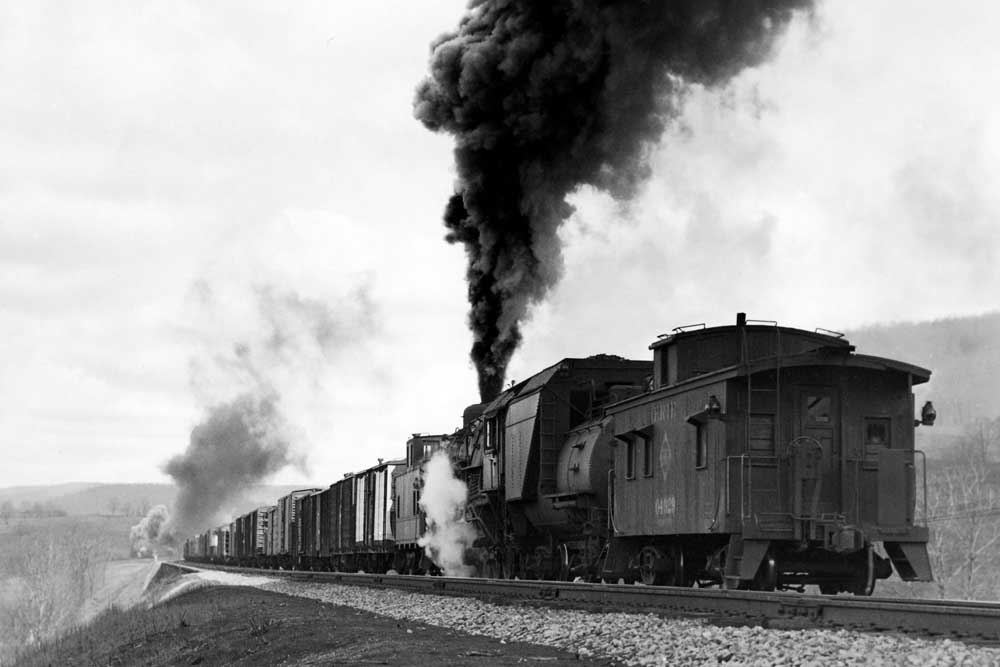






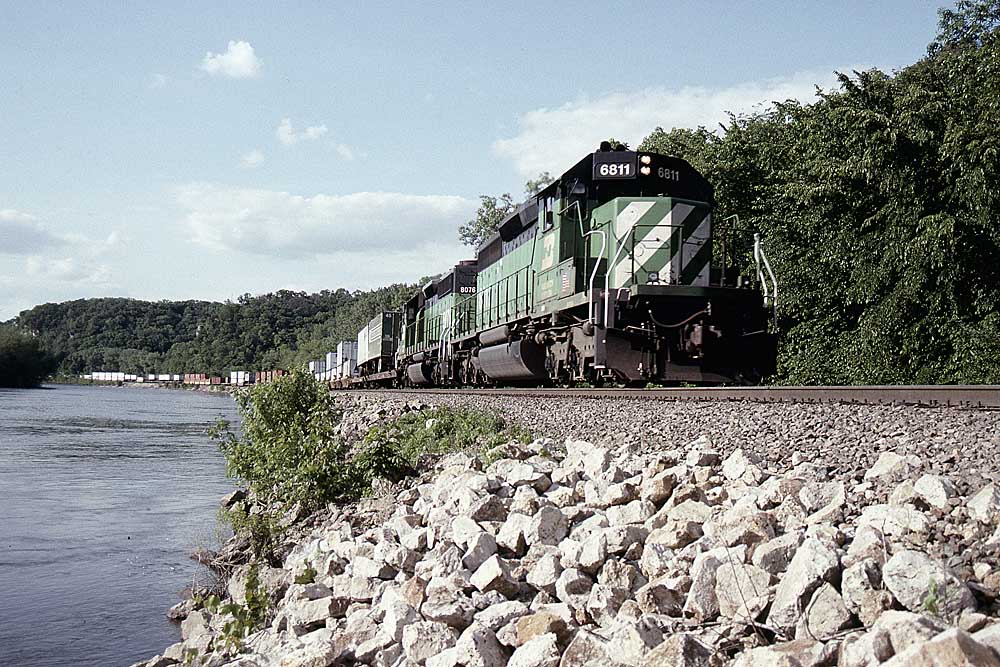
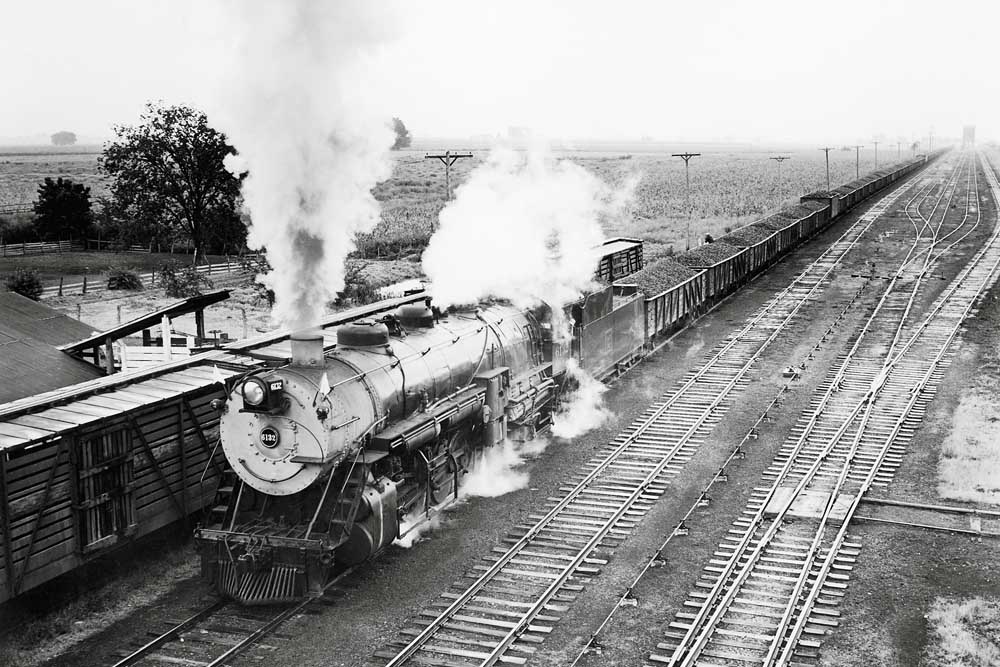
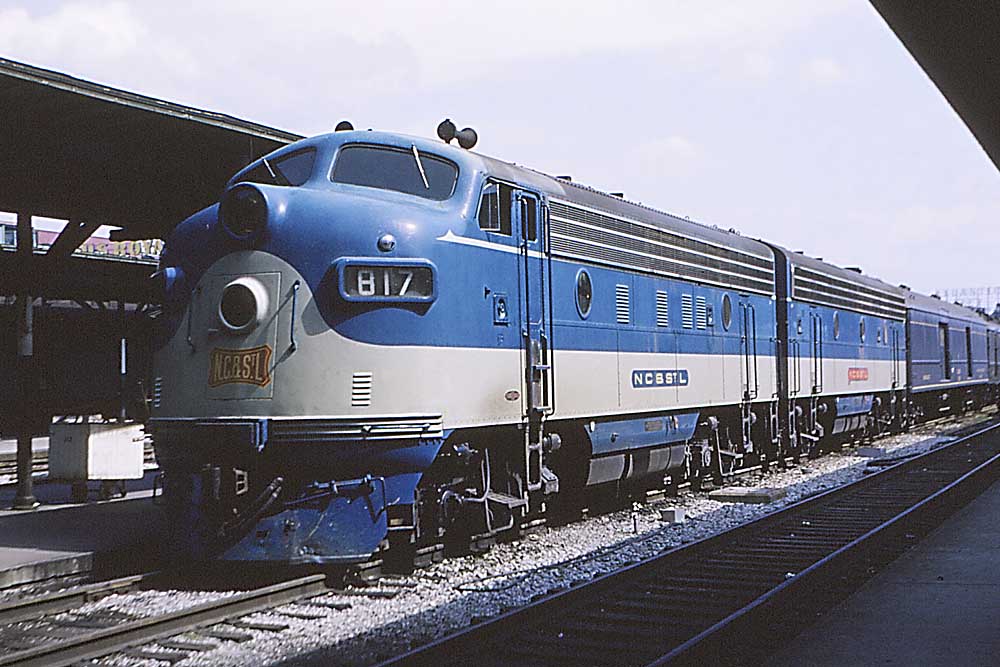
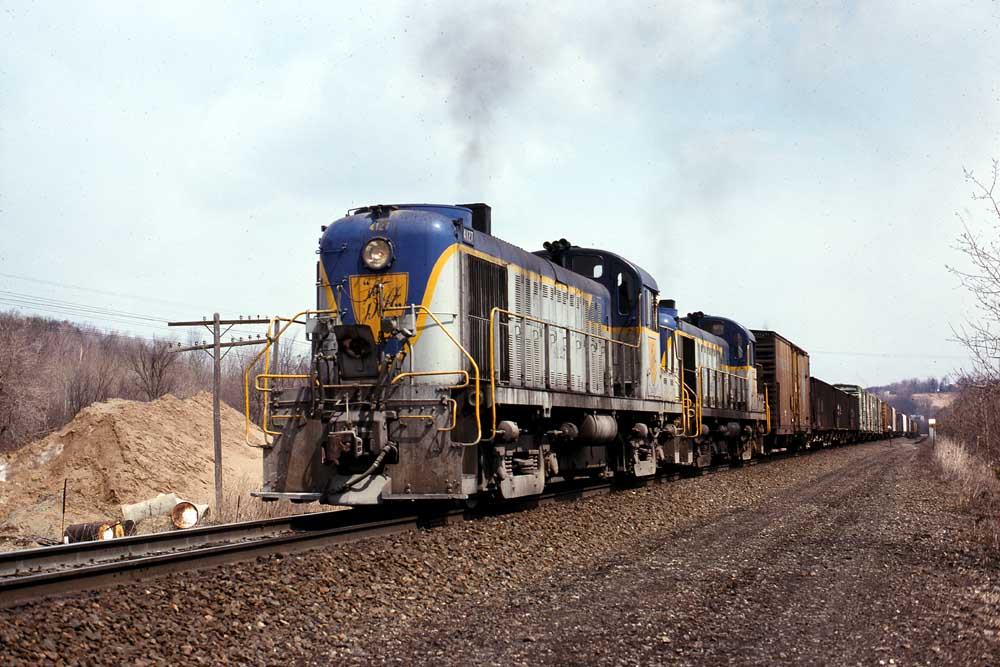




My favorite railroad of all time. We lived near the Newark Branch Allwood station and hard to believe, I rode that line only once, not long before abandonment. So many of the Erie commuter branch lines in Essex County and environs have been scrapped and, in time, lost to history. But the memories linger yet.
My grandfather worked for the Erie and when I was young would take me to watch trains at the Erie Jamestown NY station, he was a great man and very much missed and not only for the love of trains but for so much more I am in his debt.